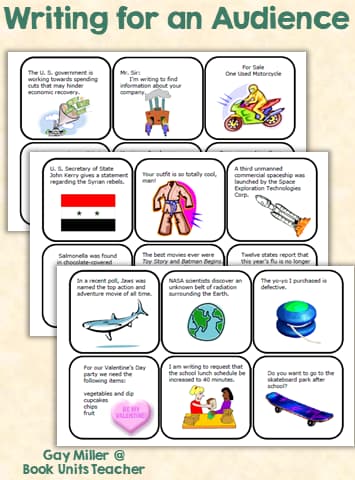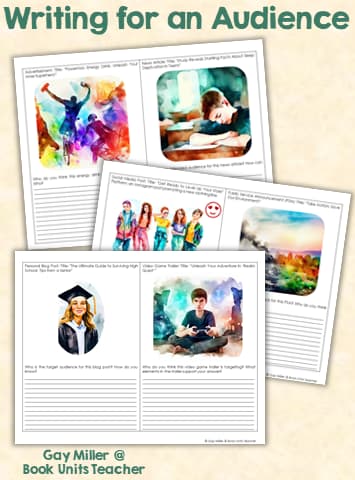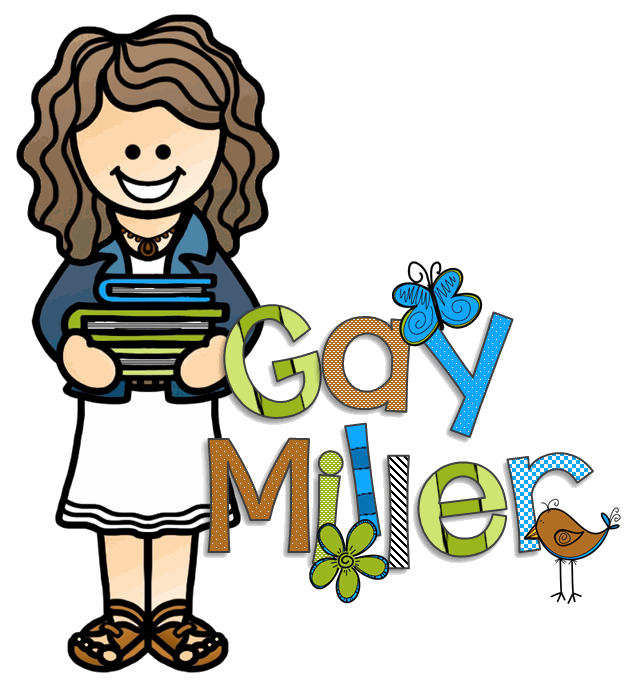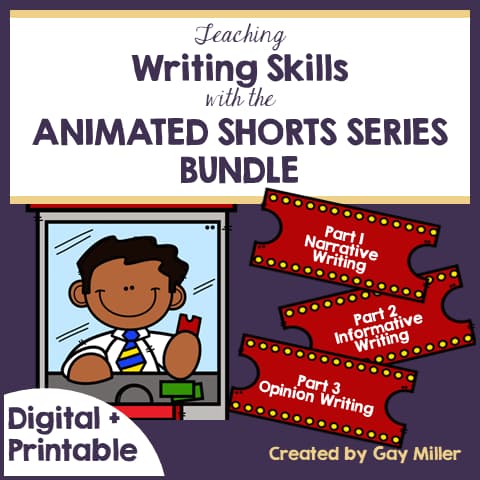
Let’s talk audience.
No, not the kind clapping politely at a school talent show while someone’s recorder squeaks out “Hot Cross Buns.” I’m talking about the kind of audience your students should be thinking about every time they put pencil to paper – or fingers to the keyboard.
Getting kids to shift their tone and style depending on who they’re writing or speaking to is one of those lightbulb moments in the classroom. And good news—this isn’t a weeklong deep dive with a stack of rubrics. With just one mini-lesson, you can have your students adjusting their voice faster than you can say, “Would you say that to your grandmother?”
Free teaching goodies included!
This post comes with a downloadable handout filled with all the printables, a PowerPoint, a Boom Learning deck, and a foldable organizer to help you teach this standard-aligned writing skill without starting from scratch.
Writing for an Audience Activities
Activity 1: Brainstorming

Start by asking students to list people they might write to. Warning: Prepare for some fun answers. You’ll get everything from LeBron James to Taylor Swift to their pet hamster, Sparkles.
Write these names on the board, then gently group them into categories like friends, celebrities, family, or teachers. This keeps things organized and helps students think more broadly.
Then comes the lightning round of questions:
- Which people would you start your letter with “Dear…”?
- Is it okay to say “What’s up?” to everyone?
- Could you toss in “lol” or “OMG” with all of these people?
Cue the giggles—and the learning.
Activity 2: Name the Audience

Now that they get the idea, it’s time for a little practice. In this activity, students read short examples and guess who the intended audience is.
The activity is available in multiple formats:
- Boom Learning Deck (great for independent centers or early finishers)
- Printable version
- PowerPoint for whole-group discussion
Never used Boom before? Here’s a super short demo video, so you can see how it works.
Activity 3: Writing for an Audience Flip Organizer

It walks students through questions they should ask themselves before writing. Questions like:
- Is this for a grade? (Translation: Do I need to bring my A-game?)
- Formal or informal? (No “wassup” in a job application, please.)
- Is this an essay, a report, a letter, or a birthday card to Grandma?
Stick it in their notebook, and you’ve got a built-in reminder they can return to all year long.
Activity 4: Media Analysis

Now it’s time to get a little real-world.
Have students analyze ads, news articles, social media posts—whatever catches their eye (or yours). The goal is to figure out who the message is meant for and how it’s crafted to speak to that group.
Not sure where to start? The handout includes six simulated examples, so you don’t have to scroll TikTok for homework (you’re welcome).
Activity 5: Real-World Writing = Real Motivation
When students write for a real audience, the stakes feel higher—and the writing gets better.
Have them post to a class blog, write a persuasive letter to a local organization, or even craft an email to the principal (about something helpful—not just why recess should be two hours long). When students know someone besides you will read it, they naturally adapt their tone, style, and word choice.
So if you’re looking for a practical, no-fluff way to help students write with purpose—and maybe even impress their future boss, coach, or English teacher—these activities are your go-to.
🖨️ Grab the handout
You’ll get all the tools to teach audience awareness without reinventing the wheel (or your lesson plans).
See the product that inspired this post.
Are you looking for a fun way to teach writing skills? This series teaches narrative, informative, and opinion writing with animated short films your students are sure to love!



